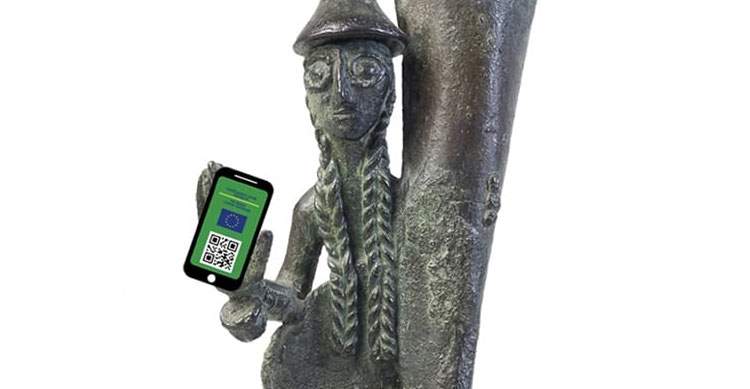Communicating thegreen pass requirement as of August 6? For many museums (where, as is well known, the measure becomes mandatory from this Friday) it is an institutional task to be carried out with aseptic language. For many others, however, it is an opportunity to communicate with the public in an appealing way. Many museums have therefore come up with special graphics: the Royal Museums of Turin, for example, chose to dye themselves green to remind everyone of the implementation of Decree-Law No. 105 of July 23. On the other hand, the Egyptian Museum of Turin, which was among the first to communicate the new provisions to its public (and they know it very well since, unfortunately, they have been covered with insults on social media) has chosen to dress the silhouette of an ancient Egyptian in a green T-shirt. The Stibbert Museum in Florence is also banking on sympathy, deciding to put two ... medieval soldiers guarding a door.
The Reggia di Caserta, on the other hand, makes Ferdinand II of Bourbon wear a green uniform, inviting the public in Neapolitan: “vacciniamoci ca ce pass’!” And again, here is the Lodovico Pogliaghi House Museum in Varese, which announces that it has going “green” and creates a poster with an invitation, “Relax. With the green pass we are all more serene.”
Finally, there are also those who try to make the green pass an opportunity for in-depth study. For the National Etruscan Museum of Villa Giulia, it is an opportunity to retrace the history of the Etruscans, who, according to the institute, would willingly accept the green pass: “It is known,” the museum writes, “that every more or less prolonged contact brings with it opportunities but also dangers. If the greatness and power of the Etruscans depended on their ability to interact and the intelligence with which they were able to derive profits and advantages from sharing their resources, all kinds of risks could lie behind these relationships. In a Mediterranean that, however seemingly large, even in ancient times could legitimately be compared to a pond (Plato) the spread of epidemics and contagions was an everyday eventuality. Until the 19th century and the first discoveries in the field of epidemiology and the development of greater sensitivity in the field of hygiene (like washing your hands after surgery!) the more obvious prevention techniques that we are used to adopt today even in our daily lives were totally unknown. For reasons such as these, mortality in the ancient world was extremely high and the average life span rarely went beyond 35 years. Literary sources and archaeological evidence have recorded countless epidemics. The causes could have been the most diverse: poor hygiene and carelessness in waste management, the possibility of contamination from corpses and carrion, living with animals, inadequate housing, malaria and other forms of contagion carried by often very inhospitable habitats, difficulties in food preservation, and, of course, contact with outside peoples. Knowing the wisdom, religious scruples and proverbial discipline of the Etruscans, it is safe to say that if they had had the green pass they would have used it without scruple as well. In this way they would have been able to carry on their activities and contacts without risk and without renunciation, as befitted a people who were great lovers of the pleasures of life. For that matter, Titus Livy already tells of how during the terrible plague of 365 B.C. in which the famous Furio Camillo also died, in order to cheat time and fear they were called from Etruria to perform in the Circus Maximus-histrions (a word not coincidentally of Etruscan origin) and dancers, giving rise to forms of theater very similar to contemporary ones. Surely the Romans could not have known that doing so actually increased the risk of contagion.” Instead, Colosseum Park recalls that even inancient Rome there was something similar, the tessera hospitalis, or “a document of recognition and guarantee, on which the names of the host and guest were engraved, indispensable for access to the Urbe.” And he establishes a comparison with the past: “Today as yesterday, a tessera hospitalis will be your pass for entry into the heart of Rome.”
As recalled, unfortunately, in the face of so many supportive comments and so many others who, though opposed to the green pass, politely expressed their dissent, there was also no shortage of uncivilized people who, as recalled above, covered the museums with insults, without, moreover, understanding that the green pass is not an autonomous decision of the museums but is a governmental provision that they are required to apply if they want to remain open. A behavior, that of those who pick on museums, obviously to be stigmatized.
Pictured: the green pass graphic of the National Etruscan Museum of Villa Giulia.
 |
| Museums invent creative ways to communicate green pass requirement from Aug. 6 |
Warning: the translation into English of the original Italian article was created using automatic tools. We undertake to review all articles, but we do not guarantee the total absence of inaccuracies in the translation due to the program. You can find the original by clicking on the ITA button. If you find any mistake,please contact us.